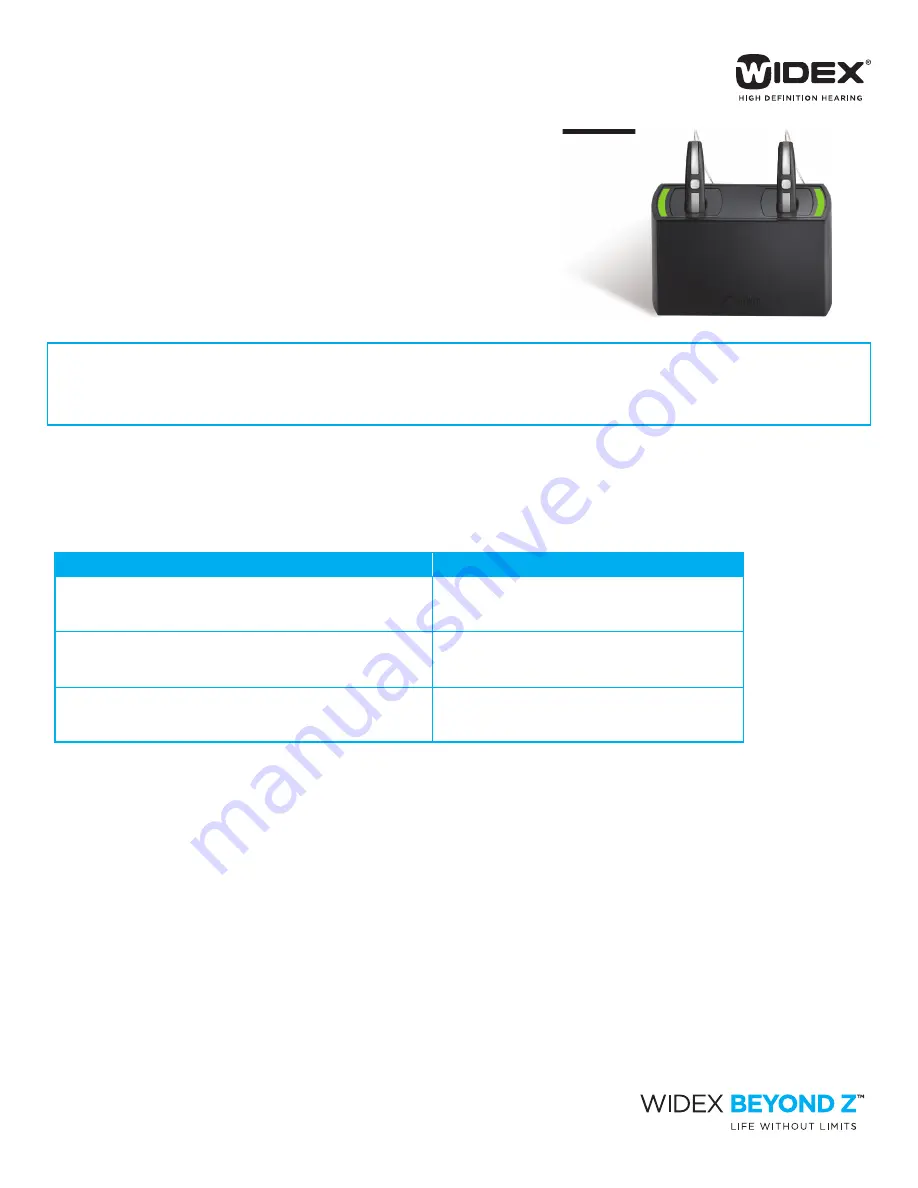
WIDEX
BEYOND Z
MAINTENANCE
QUICK GUIDE
WWW.
WIDEX
.COM
LONG-TERM USE
Your rechargeable battery should last approximately 12 months. At the end of the battery life, you will notice the battery will not last
throughout the day. Contact your local hearing healthcare professional for more information on replacing your rechargeable battery
at that time. The battery is recyclable where you recycle other batteries.
EXTENDING THE LIFE OF YOUR BATTERY
• Charge your hearing aids nightly. Avoid skipping nights or partially charging the batteries.
• Do not restart the hearing aids by opening/closing the battery door if you hear the low battery warning or after the battery appears
to have lost its charge. Restarting has the potential to cause long term reduction of battery performance if done repeatedly.
• When not in use, keep the hearing aids on the charger and ensure that the charger is plugged into an active power source.
• For prolonged inactivity, remove the battery from the hearing aid. Note: It may take several charging cycles for the battery to return
to full performance
• Perform regular cleaning maintenance to keep your hearing aid and battery door clean from debris.
• Do not put the rechargeable battery into a hearing aid dryer.
• Avoid long exposures to excessive cold or heat. Temperatures include:
- Operating temperatures: Min 0 to Max 40 degrees Celsius (32 degrees to 104 degrees F)
- Storage temperatures: Min -20 to Max 50 degrees Celsius (-4 degrees to 122 degrees F)
For additional information on function and performance, consult the full ZPower Manual or contact your hearing healthcare professional.
USING A HEARING AID DEHUMIDIFIER, DRYER, OR DESICCANT KIT
Widex recommends regular use of a hearing aid dehumidifi er; however, it is important to understand proper use with the rechargeable battery.
•
Important: The rechargeable battery should not go into a hearing aid dryer that is 113 degrees Fahr/- 5 degrees or warmer.
Remove the battery from the hearing aids before using a dryer to avoid reducing the long-term cycle life of the battery.
Possible suggestions for using a hearing aid dehumidifi er with the hearing aids:
Possible Use
Battery and Battery Door Set-Up
Use desiccant jar for 1-2 hours a day when not wearing the
hearing aids (e.g. during a nap, when showering, etc.).
• Leave the battery in
• Open the battery door completely
• Charge the battery overnight in the charger
Use a hearing aid dryer for 1-2 hours a day when not wearing
the hearing aids (e.g. during a nap, when showering, etc.).
• Remove the battery
• Open the battery door
• Charge the battery overnight in the charger
Use a hearing aid dryer for a full cycle weekly when not
wearing the hearing aids.
• Remove the battery
• Open the battery door
• Charge the battery overnight in the charger
CRM13
/1217
NIGHTLY ROUTINE
• Each night, place your hearing aids on the charger with the earwire/earpiece
on the side of the charger cord.
• If inserted correctly, a green light will start slowly pulsing on the charger.
• Once fully charged, the light will turn to a solid green.
• In the morning, take the hearing aids off of the charger. They will automatically
turn on once removed from charger.
• There is no need to open/close the battery door during this daily charging process.
RECOMMENDATION: There is no risk in overcharging. As such, it is recommended to put the hearing aids on the charger when not in use.
If you forget to charge your rechargeable hearing aids, you can replace the battery with a disposable battery (silver in color). Make sure to store
your rechargeable battery (gold in color) in a secure place so that you can return the gold battery to the hearing aid before charging at night.
If you accidentally put the silver disposable battery on the charger at night, a red fl ashing light will appear on the charger. Remove this battery
and replace it with the appropriate rechargeable battery (gold color).








